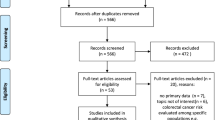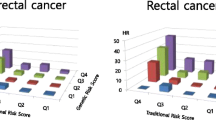Abstract
Background
Little is known about the difference of genetic predisposition for CRC between ethnicities; however, many genetic traits common to colorectal cancer have been identified. This study investigated whether more SNPs identified in GWAS in East Asian population could improve the risk prediction of Japanese and explored possible application of genetic risk groups as an instrument of the risk communication.
Methods
558 Patients histologically verified colorectal cancer and 1116 first-visit outpatients were included for derivation study, and 547 cases and 547 controls were for replication study. Among each population, we evaluated prediction models for the risk of CRC that combined the genetic risk group based on SNPs from GWASs in European-population and a similarly developed model adding SNPs from GWASs in East Asian-population. We examined whether adding East Asian-specific SNPs would improve the discrimination.
Results
Six SNPs (rs6983267, rs4779584, rs4444235, rs9929218, rs10936599, rs16969681) from 23 SNPs by European-based GWAS and five SNPs (rs704017, rs11196172, rs10774214, rs647161, rs2423279) among ten SNPs by Asian-based GWAS were selected in CRC risk prediction model. Compared with a 6-SNP-based model, an 11-SNP model including Asian GWAS-SNPs showed improved discrimination capacity in Receiver operator characteristic analysis. A model with 11 SNPs resulted in statistically significant improvement in both derivation (P = 0.0039) and replication studies (P = 0.0018) compared with six SNP model. We estimated cumulative risk of CRC by using genetic risk group based on 11 SNPs and found that the cumulative risk at age 80 is approximately 13% in the high-risk group while 6% in the low-risk group.
Conclusion
We constructed a more efficient CRC risk prediction model with 11 SNPs including newly identified East Asian-based GWAS SNPs (rs704017, rs11196172, rs10774214, rs647161, rs2423279). Risk grouping based on 11 SNPs depicted lifetime difference of CRC risk. This might be useful for effective individualized prevention for East Asian.


Similar content being viewed by others
References
Aaltonen L, Johns L, Jarvinen H, Mecklin JP, Houlston R (2007) Explaining the familial colorectal cancer risk associated with mismatch repair (MMR)-deficient and MMR-stable tumors. Clin Cancer Res 13:356–361. doi:10.1158/1078-0432.ccr-06-1256
Amos CI et al (2008) Genome-wide association scan of tag SNPs identifies a susceptibility locus for lung cancer at 15q25.1. Nat Genet 40:616–622. doi:10.1038/ng.109
Bosetti C et al (2008) Tobacco smoking, smoking cessation, and cumulative risk of upper aerodigestive tract cancers. Am J Epidemiol 167:468–473. doi:10.1093/aje/kwm318
Broderick P et al (2007) A genome-wide association study shows that common alleles of SMAD7 influence colorectal cancer risk. Nat Genet 39:1315–1317. doi:10.1038/ng.2007.18
Chan M et al (2011) Evaluation of nanofluidics technology for high-throughput SNP genotyping in a clinical setting. J Mol Diagn 13:305–312. doi:10.1016/j.jmoldx.2010.12.001
Cui R et al (2011) Common variant in 6q26–q27 is associated with distal colon cancer in an Asian population. Gut 60:799–805. doi:10.1136/gut.2010.215947
Cunningham D, Atkin W, Lenz HJ, Lynch HT, Minsky B, Nordlinger B, Starling N (2010) Colorectal cancer. Lancet 375:1030–1047. doi:10.1016/S0140-6736(10)60353-4
DeLong ER, DeLong DM, Clarke-Pearson DL (1988) Comparing the areas under two or more correlated receiver operating characteristic curves: a nonparametric approach. Biometrics 44:837–845
Dunlop MG et al (2012) Common variation near CDKN1A, POLD3 and SHROOM2 influences colorectal cancer risk. Nat Genet 44:770–776. doi:10.1038/ng.2293
Fugger L, McVean G, Bell JI (2012) Genomewide association studies and common disease–realizing clinical utility. N Engl J Med 367:2370–2371. doi:10.1056/NEJMp1212285
Ferlay J, Soerjomataram I, Ervik M, Dikshit R, Eser S, Mathers C, Rebelo M, Parkin DM, Forman D, Bray F (2013) GLOBOCAN 2012 v1.0, Cancer incidence and mortality worldwide: IARC cancerbase no 11. International Agency for Research on Cancer, Lyon, France. Available from:http://globocan.iarc.fr. Accessed on 4 July 2015
Hamajima N et al (2001) Gene–environment interactions and polymorphism studies of cancer risk in the Hospital-based Epidemiologic Research Program at Aichi Cancer Center II (HERPACC-II). Asian Pac J Cancer Prev 2:99–107
Hosmer DW, Lemeshow L (2000) Applied logistic regression, 2nd edn. Wiley, Amsterdam
Hosono S et al (2016) A risk prediction model for colorectal cancer using genome-wide association study-identified polymorphisms and established risk factors among Japanese: results from two independent case–control studies. Eur J Cancer Prev 25:500–507. doi:10.1097/CEJ.0000000000000213
Houlston RS et al (2008) Meta-analysis of genome-wide association data identifies four new susceptibility loci for colorectal cancer. Nat Genet 40:1426–1435. doi:10.1038/ng.262
Houlston RS et al (2010) Meta-analysis of three genome-wide association studies identifies susceptibility loci for colorectal cancer at 1q41, 3q26.2, 12q13.13 and 20q13.33. Nat Genet 42:973–977. doi:10.1038/ng.670
Imaeda N, Goto C, Tokudome Y, Hirose K, Tajima K, Tokudome S (2007) Reproducibility of a short food frequency questionnaire for Japanese general population. J Epidemiol 17:100–107
Inoue M, Tajima K, Hirose K, Hamajima N, Takezaki T, Kuroishi T, Tominaga S (1997) Epidemiological features of first-visit outpatients in Japan: comparison with general population and variation by sex, age, and season. J Clin Epidemiol 50:69–77
Ito H, Matsuo K (2016) Molecular epidemiology, and possible real-world applications in breast cancer. Breast Cancer 23:33–38. doi:10.1007/s12282-015-0609-8
Ito H et al (2012) Association between a genome-wide association study-identified locus and the risk of lung cancer in Japanese population. J Thorac Oncol 7:790–798. doi:10.1097/JTO.0b013e3182475028
Jia WH et al (2013) Genome-wide association analyses in East Asians identify new susceptibility loci for colorectal cancer. Nat Genet 45:191–196. doi:10.1038/ng.2505
Katanoda K et al (2015) An updated report on the trends in cancer incidence and mortality in Japan, 1958–2013. Jpn J Clin Oncol 45:390–401. doi:10.1093/jjco/hyv002
Levin B et al (2008) Screening and surveillance for the early detection of colorectal cancer and adenomatous polyps, 2008: a joint guideline from the American Cancer Society, the US Multi-Society Task Force on Colorectal Cancer, and the American College of Radiology. Gastroenterology 134:1570–1595. doi:10.1053/j.gastro.2008.02.002
Lichtenstein P et al (2000) Environmental and heritable factors in the causation of cancer–analyses of cohorts of twins from Sweden, Denmark, and Finland. N Engl J Med 343:78–85. doi:10.1056/NEJM200007133430201
Lieberman DA (2009) Clinical practice. Screening for colorectal cancer. N Engl J Med 361:1179–1187. doi:10.1056/NEJMcp0902176
Ma J et al (1997) Methylenetetrahydrofolate reductase polymorphism, dietary interactions, and risk of colorectal cancer. Cancer Res 57:1098–1102
Matsuda A, Matsuda T, Shibata A, Katanoda K, Sobue T, Nishimoto H, Japan Cancer Surveillance Research G (2014) Cancer incidence and incidence rates in Japan in 2008: a study of 25 population-based cancer registries for the Monitoring of Cancer Incidence in Japan (MCIJ) project. Jpn J Clin Oncol 44:388–396. doi:10.1093/jjco/hyu003
Matsuo K et al (2009) Association between an 8q24 locus and the risk of colorectal cancer in Japanese. BMC Cancer 9:379. doi:10.1186/1471-2407-9-379
Peto R, Darby S, Deo H, Silcocks P, Whitley E, Doll R (2000) Smoking, smoking cessation, and lung cancer in the UK since 1950: combination of national statistics with two case-control studies. BMJ 321:323–329
Real LM et al (2014) A colorectal cancer susceptibility new variant at 4q26 in the Spanish population identified by genome-wide association analysis. PLoS One 9:e101178. doi:10.1371/journal.pone.0101178
Salinas CA et al (2009) Clinical utility of five genetic variants for predicting prostate cancer risk and mortality. Prostate 69:363–372. doi:10.1002/pros.20887
Sano H, Goto R, Hamashima C (2014) What is the most effective strategy for improving the cancer screening rate in Japan? Asian Pac J Cancer Prev 15:2607–2612
Slattery ML et al (2010) Increased risk of colon cancer associated with a genetic polymorphism of SMAD7. Cancer Res 70:1479–1485. doi:10.1158/0008-5472.can-08-1792
Suzuki T et al (2007) Effect of familial history and smoking on common cancer risks in Japan. Cancer 109:2116–2123. doi:10.1002/cncr.22685
Tajima K, Hirose K, Inoue M, Takezaki T, Hamajima N, Kuroishi T (2000) A model of practical cancer prevention for out-patients visiting a hospital: the Hospital-based Epidemiologic Research Program at Aichi Cancer Center (HERPACC). Asian Pac J Cancer Prev 1:35–47
Tenesa A et al (2008) Genome-wide association scan identifies a colorectal cancer susceptibility locus on 11q23 and replicates risk loci at 8q24 and 18q21. Nat Genet 40:631–637. doi:10.1038/ng.133
Thompson CL, Plummer SJ, Acheson LS, Tucker TC, Casey G, Li L (2009) Association of common genetic variants in SMAD7 and risk of colon cancer. Carcinogenesis 30:982–986. doi:10.1093/carcin/bgp086
Thorgeirsson TE et al (2008) A variant associated with nicotine dependence, lung cancer and peripheral arterial disease. Nature 452:638–642. doi:10.1038/nature06846
Tokudome Y et al (2005) Relative validity of a short food frequency questionnaire for assessing nutrient intake versus three-day weighed diet records in middle-aged Japanese. J Epidemiol 15:135–145
Tomlinson I et al (2007) A genome-wide association scan of tag SNPs identifies a susceptibility variant for colorectal cancer at 8q24.21. Nat Genet 39:984–988. doi:10.1038/ng2085
Tomlinson IP et al (2011) Multiple common susceptibility variants near BMP pathway loci GREM1, BMP4, and BMP2 explain part of the missing heritability of colorectal cancer. PLoS Genet 7:e1002105. doi:10.1371/journal.pgen.1002105
US Preventive Services Task Force (2008) Summaries for patients. Screening for colorectal cancer: U.S. Preventive Services Task Force recommendation. Ann Intern Med 149:44
van Zitteren M, van der Net JB, Kundu S, Freedman AN, van Duijn CM, Janssens AC (2011) Genome-based prediction of breast cancer risk in the general population: a modeling study based on meta-analyses of genetic associations. Cancer Epidemiol Biomarkers Prev 20:9–22. doi:10.1158/1055-9965.epi-10-0329
von Holst S et al (2010) Association studies on 11 published colorectal cancer risk loci. Br J Cancer 103:575–580. doi:10.1038/sj.bjc.6605774
Wacholder S et al (2010) Performance of common genetic variants in breast-cancer risk models. N Engl J Med 362:986–993. doi:10.1056/NEJMoa0907727
Wang J et al (2009) High-throughput single nucleotide polymorphism genotyping using nanofluidic Dynamic Arrays. BMC Genomics 10:561. doi:10.1186/1471-2164-10-561
World Cancer Report (2014) International agency for research on cancer. World Health Organization, Geneva
Wu X et al (2007) Projecting individualized probabilities of developing bladder cancer in white individuals. J Clin Oncol 25:4974–4981. doi:10.1200/jco.2007.10.7557
Xing J et al (2011) GWAS-identified colorectal cancer susceptibility locus associates with disease prognosis. Eur J Cancer 47:1699–1707. doi:10.1016/j.ejca.2011.02.004
Zanke BW et al (2007) Genome-wide association scan identifies a colorectal cancer susceptibility locus on chromosome 8q24. Nat Genet 39:989–994. doi:10.1038/ng2089
Zhang B et al (2014) Large-scale genetic study in East Asians identifies six new loci associated with colorectal cancer risk. Nat Genet 46:533–542. doi:10.1038/ng.2985
Zheng SL et al (2008) Cumulative association of five genetic variants with prostate cancer. N Engl J Med 358:910–919. doi:10.1056/NEJMoa075819
Zipkin DA et al (2014) Evidence-based risk communication: a systematic review. Ann Intern Med 161:270–280. doi:10.7326/M14-0295
Acknowledgements
The authors appreciate the efforts of the many contributors to the HERPACC study. This study was supported by Grants-in-Aid for Scientific Research on Priority Areas from the Ministry of Education, Science, Sports, Culture and Technology of Japan; by the National Cancer Center Research and Development Fund (H25-A-14); by a Grant-in-Aid for the Third Term Comprehensive 10-year Strategy for Cancer Control from the Ministry of Health, Labour and Welfare of Japan and the Health and JSPS KAKENHI Grant Number 26253041and 25460786. These grantors were not involved in the study design, subject enrollment, study analysis or interpretation, or submission of the manuscript for this study.
Author information
Authors and Affiliations
Corresponding author
Ethics declarations
Conflict of interest
The authors declare that no competing interests exist.
Electronic supplementary material
Below is the link to the electronic supplementary material.
Rights and permissions
About this article
Cite this article
Abe, M., Ito, H., Oze, I. et al. The more from East-Asian, the better: risk prediction of colorectal cancer risk by GWAS-identified SNPs among Japanese. J Cancer Res Clin Oncol 143, 2481–2492 (2017). https://doi.org/10.1007/s00432-017-2505-4
Received:
Accepted:
Published:
Issue Date:
DOI: https://doi.org/10.1007/s00432-017-2505-4




